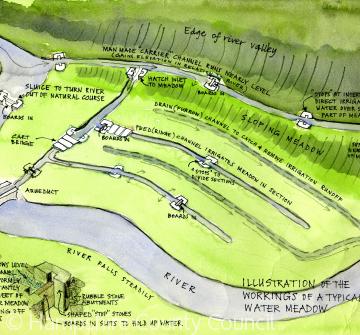Floated Water Meadows

A slow but steady flow of river water right across the meadow (known as ‘drowning’ the meadow), kept the ground slightly warmer than it would be if exposed to winter frosts, and also nourishing it with alluvial deposits. If successful this would cause greater amounts of grass, in turn enabling farmers to keep more sheep.
Creating a floated water meadow was expensive and involved skilful surveying and engineering. A main carriage (rather like a mill leat) was created, drawing water from the river upstream of the meadow. The intake and flow along it were controlled by hatches – small removable wooden dams. When full to overflowing the main carriage spilled water into smaller channels, known as carriers, which fanned out across the meadow. Between the carriers, and slightly lower, were drains, which fed the water into a main or tail drain, which in turn took the water back to the river further downstream.
Content generated during research for the paperback book 'Codford: Wool and War in Wiltshire' (ISBN 13 : 978-1-86077-441-6 ) for the England's Past for Everyone series




